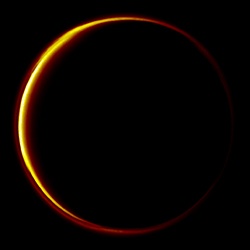Kylene Polhamus, OD, co-authored today’s blog. She is an optometrist with Boling Vision Center with specializations including treatment and management of ocular disease and pediatrics.
 A total eclipse once signaled the end of the world—or at least a message from God. Though a total eclipse may not seem so significant today, it is still a big deal. Those who have experienced one describe it as night falling—suddenly—in the middle of the day. It gets so dark that the stars appear in the sky, summer insects strike up their evening chorus, and birds fall quiet. You can see beads around the dark moon and maybe tongues of red fire around the edge of the sun. And it’s over in minutes.
A total eclipse once signaled the end of the world—or at least a message from God. Though a total eclipse may not seem so significant today, it is still a big deal. Those who have experienced one describe it as night falling—suddenly—in the middle of the day. It gets so dark that the stars appear in the sky, summer insects strike up their evening chorus, and birds fall quiet. You can see beads around the dark moon and maybe tongues of red fire around the edge of the sun. And it’s over in minutes.
In less than two weeks, on August 21, 2017, America will experience its first total eclipse in 38 years. It will travel from coast to coast, which hasn’t happened in nearly a century, cutting a “path of totality” across the middle of the continent. Although Indiana is (just) too far north to experience the total eclipse, we can experience a partial eclipse. In South Bend, where we’re writing, the eclipse will begin at 12:57 p.m. and last nearly three hours. At 2:22 p.m., the moon will cover 88% of the sun. (You can check this information for your own location here.)
That will be something to see—but not without proper eye protection.
You cannot safely look at the sun—even if it’s partially covered. Looking directly at the sun allows ultraviolet rays, which normally bounce off objects before reaching your eyes, to reach light receptor cells at the back of your eyes in harmful concentrations. Even just one minute looking at the sun can cause temporary or permanent damage to your eyesight. Known as solar retinopathy, this condition may include distorted vision, a blind spot in the center of your sight, or loss of vision.
Children and young adults are particularly at risk. Younger eyes, with larger pupils or less wear and tear, allow more UV rays to get through to the back of the eye. And children may not be as aware that looking at the sun is dangerous.
So if you plan to experience the eclipse on August 21st, make sure you follow some basic safety:
- Do not look directly at a partial eclipse with the naked eye or even sunglasses.
- You can look at a partial eclipse wearing “eclipse glasses.” Safe eclipse glasses allow you to view the sun in focus and about as bright as the full moon. The American Astronomical Society has a list of reputable vendors on their website.
- If you already have a pair and you’re not sure if they are from a reputable vendor, review the AAS’s guidelines for telling whether eclipse glasses are safe.
- Before you use eclipse glasses, check to make sure they are not scratched, torn, or punctured.
- When you’re wearing the eclipse glasses, don’t walk anywhere. If you need to move, take them off—just make sure you’re not looking at the sun when you do!
- If you don’t have eclipse glasses, you can still experience the eclipse with a pin-hole camera you can make with some paper and aluminum foil. NASA has easy directions on their website.
A solar eclipse—even a partial one—encourages curiosity and ignites imagination in children. For adults, it reminds us that the world is still full of wonder and awe. It’s an event that creates lifelong memories. But eclipses don’t come around often. The next total eclipse over the continental U.S. will be in about seven years on April 8, 2024—then another 21 years after that.
So don’t miss this one. Grab your eclipse glasses or make a pinhole camera and get outside on August 21st!
 Kylene Polhamus, OD, is an optometrist with Boling Vision Center. She earned her undergraduate degree in Chemistry at Butler University and received her Doctor of Optometry degree from IU School of Optometry. Dr. Polhamus is a certified member of the American Optometric Association as well as the Indiana Optometric Association. She practices full scope optometry and specializes in the treatment and management of ocular disease, surgical co-management, pediatrics, routine eye care (glasses & contacts) for all ages, and botox injections.
Kylene Polhamus, OD, is an optometrist with Boling Vision Center. She earned her undergraduate degree in Chemistry at Butler University and received her Doctor of Optometry degree from IU School of Optometry. Dr. Polhamus is a certified member of the American Optometric Association as well as the Indiana Optometric Association. She practices full scope optometry and specializes in the treatment and management of ocular disease, surgical co-management, pediatrics, routine eye care (glasses & contacts) for all ages, and botox injections.




